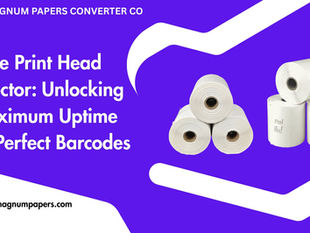|
|
|
|

Roll, Ribbon, Revolution: The Magnum Guide to Print Integrity and Efficiency
2 days ago
3 min read
0
0
0

Introduction: The Unseen Frontier of Manufacturing 🏭
In the modern manufacturing and supply chain landscape, a silent revolution is underway: the quest for Print Integrity and Efficiency. While large-scale automation and smart factory floors often capture the spotlight, the seemingly humble act of printing—whether it's for labels, compliance documents, product traceability, or internal paperwork—remains a critical and often overlooked touchpoint.
The title "Roll, Ribbon, Revolution" captures the core elements of this modern challenge, particularly in high-volume, continuous printing environments. It refers to the Roll (the media, like labels or paper), the Ribbon (the thermal transfer material providing durable ink), and the Revolution (the technological advancements ensuring quality and speed). Ensuring integrity and maximizing efficiency in this process isn't just about saving paper; it’s about data security, compliance adherence, brand protection, and overall operational resilience.
Part I: The Quest for Print Integrity 🛡️
Print integrity is paramount, especially in regulated industries like pharmaceuticals, food and beverage, and logistics. An error in a printed label can halt an entire product recall, compromise safety, or lead to massive compliance fines.
Key Pillars of Integrity:
Data Accuracy and Verification: The printed information must perfectly match the source data. This requires automated systems that can perform real-time verification against a central database. Solutions like print inspection cameras or scanners check for correct barcodes, sequence numbers, and text before the item leaves the production line.
Traceability and Audit Trails: Integrity extends beyond the final print. Every print job—including the printer, the user, the time, and the data source—must be logged. This creates an unbreakable digital audit trail that is essential for compliance (e.g., ISO 27001, GDPR) and fast issue resolution.
Security of the Print Environment: Networked printers are often a weak link in a corporate network, vulnerable to data interception and breaches. Secure Print Release (requiring authentication at the device) and data encryption for print jobs are fundamental best practices to safeguard sensitive supply chain and proprietary information.
Part II: Driving Print Efficiency with Modern Technology ⚙️
Efficiency in printing translates directly to lower operational costs, reduced waste, and faster production cycles. Modern print management and technology move far beyond simply replacing ink and paper.
Technological Drivers of Efficiency:
Centralized Print Management (CPM): Fragmentation leads to waste and downtime. CPM systems provide a single pane of glass to manage a mixed fleet of printers, automate consumable reordering, and apply fleet-wide settings like default duplex printing. This minimizes bottlenecks and staff frustration.
Thermal Transfer Ribbons (TTR) and Media Selection: The Ribbon itself is a key efficiency factor. Choosing the correct ribbon type (wax, wax-resin, or full resin) for the substrate (the Roll) ensures longevity and prevents print failures, reducing rework. High-quality ribbons provide better resistance to smudging, scratching, and chemicals, ensuring a first-time-right print.
Lean Printing and Workflow Optimization: Principles of Lean Manufacturing—such as eliminating waste (unused inventory, unnecessary steps) and establishing Standard Works—are being applied to printing. Automated pre-press checks, batch printing, and seamless integration with Enterprise Resource Planning (ERP) systems eliminate manual errors and downtime.
Conclusion: Embracing the Print Revolution 🚀
The "Roll, Ribbon, Revolution" is not a future concept; it is the current standard for competitive manufacturing. By focusing equally on Print Integrity—securing data, ensuring accuracy, and maintaining compliance—and Print Efficiency—optimizing workflows, standardizing processes, and leveraging advanced TTR technology—organizations transform printing from a cost center into a strategic asset.
The continuous advancement of printer firmware, verification cameras, and print management software ensures that businesses can meet increasing regulatory demands while simultaneously driving down costs and improving the speed of their operations. The magnum guide's final lesson is this: Treat your printing process as the crucial, sensitive manufacturing step it is, and you will unlock unprecedented levels of integrity and efficiency.






